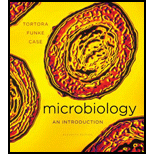
Microbiology: An Introduction
11th Edition
ISBN: 9780321733603
Author: Gerard J. Tortora, Berdell R. Funke, Christine L. Case
Publisher: Benjamin Cummings
expand_more
expand_more
format_list_bulleted
Concept explainers
Textbook Question
Chapter 1, Problem 4R
Match the microorganisms in column A to their descriptions in column B.
| Column A |
Column B |
| ___ a. Archaea | 1. Not composed of cells |
| __ b. Algae | 2. Cell wall made of chitin |
| ___ c. Bacteria | 3. Cell wall made of peptidoglycan |
| ___ d. |
4. Cell wall made of cellulose; photosynthetic |
| ___ e. Helminths | 5. Unicellular, complex cell structure lacking a cell wall |
| ___ f. Protozoa | 6. Multicellular animals |
| ___ g. Viruses | 7. Prokaryote without peptidoglycan cell wall |
Expert Solution & Answer
Want to see the full answer?
Check out a sample textbook solution
Students have asked these similar questions
What is the concept "calories consumed must equal calories burned" in regrads to nutrition?
You intend to insert patched dominant negative DNA into the left half of the neural tube of a chick.
1) Which side of the neural tube would you put the positive electrode to ensure that the DNA ends up on the left side?
2) What would be the internal (within the embryo) control for this experiment?
3) How can you be sure that the electroporation method itself is not impacting the embryo?
4) What would you do to ensure that the electroporation is working? How can you tell?
Describe a method to document the diffusion path and gradient of Sonic Hedgehog through the chicken embryo. If modifying the protein, what is one thing you have to consider in regards to maintaining the protein’s function?
Chapter 1 Solutions
Microbiology: An Introduction
Ch. 1 - Review 1. How did the idea of spontaneous...Ch. 1 - Briefly state the role microorganisms play in each...Ch. 1 - Into which field of microbiology would the...Ch. 1 - Match the microorganisms in column A to their...Ch. 1 - Match the people in column A to their contribution...Ch. 1 - It is possible to purchase the following...Ch. 1 - NAME IT What type of microorganism has a...Ch. 1 - DRAW IT Show where airborne microbes ended up in...Ch. 1 - Prob. 9RCh. 1 - How did the theory of biogenesis lead the way for...
Ch. 1 - Even though the germ theory of disease was not...Ch. 1 - Prob. 3ACh. 1 - Find at least three supermarket products made by...Ch. 1 - Multiple Choice
1. Which of the following is a...Ch. 1 - 2. Which of the following is not a characteristic...Ch. 1 - Prob. 3MCQCh. 1 - Prob. 4MCQCh. 1 - Prob. 5MCQCh. 1 -
6. Which of the following is a beneficial...Ch. 1 - Prob. 7MCQCh. 1 - Prob. 8MCQCh. 1 - Prob. 9MCQCh. 1 - 10. Which of the following statements about E....Ch. 1 - Prob. 1CAECh. 1 - In 1864, Lister observed that patients recovered...
Knowledge Booster
Learn more about
Need a deep-dive on the concept behind this application? Look no further. Learn more about this topic, biology and related others by exploring similar questions and additional content below.Similar questions
- The following table is from Kumar et. al. Highly Selective Dopamine D3 Receptor (DR) Antagonists and Partial Agonists Based on Eticlopride and the D3R Crystal Structure: New Leads for Opioid Dependence Treatment. J. Med Chem 2016.arrow_forwardThe following figure is from Caterina et al. The capsaicin receptor: a heat activated ion channel in the pain pathway. Nature, 1997. Black boxes indicate capsaicin, white circles indicate resinferatoxin. You are a chef in a fancy new science-themed restaurant. You have a recipe that calls for 1 teaspoon of resinferatoxin, but you feel uncomfortable serving foods with "toxins" in them. How much capsaicin could you substitute instead?arrow_forwardWhat protein is necessary for packaging acetylcholine into synaptic vesicles?arrow_forward
- 1. Match each vocabulary term to its best descriptor A. affinity B. efficacy C. inert D. mimic E. how drugs move through body F. how drugs bind Kd Bmax Agonist Antagonist Pharmacokinetics Pharmacodynamicsarrow_forward50 mg dose of a drug is given orally to a patient. The bioavailability of the drug is 0.2. What is the volume of distribution of the drug if the plasma concentration is 1 mg/L? Be sure to provide units.arrow_forwardDetermine Kd and Bmax from the following Scatchard plot. Make sure to include units.arrow_forward
- Choose a catecholamine neurotransmitter and describe/draw the components of the synapse important for its signaling including synthesis, packaging into vesicles, receptors, transporters/degradative enzymes. Describe 2 drugs that can act on this system.arrow_forwardThe following figure is from Caterina et al. The capsaicin receptor: a heat activated ion channel in the pain pathway. Nature, 1997. Black boxes indicate capsaicin, white circles indicate resinferatoxin. a) Which has a higher potency? b) Which is has a higher efficacy? c) What is the approximate Kd of capsaicin in uM? (you can round to the nearest power of 10)arrow_forwardWhat is the rate-limiting-step for serotonin synthesis?arrow_forward
arrow_back_ios
SEE MORE QUESTIONS
arrow_forward_ios
Recommended textbooks for you
- Basic Clinical Lab Competencies for Respiratory C...NursingISBN:9781285244662Author:WhitePublisher:Cengage
 Biology: The Dynamic Science (MindTap Course List)BiologyISBN:9781305389892Author:Peter J. Russell, Paul E. Hertz, Beverly McMillanPublisher:Cengage Learning
Biology: The Dynamic Science (MindTap Course List)BiologyISBN:9781305389892Author:Peter J. Russell, Paul E. Hertz, Beverly McMillanPublisher:Cengage Learning 
 Biology 2eBiologyISBN:9781947172517Author:Matthew Douglas, Jung Choi, Mary Ann ClarkPublisher:OpenStax
Biology 2eBiologyISBN:9781947172517Author:Matthew Douglas, Jung Choi, Mary Ann ClarkPublisher:OpenStax

Basic Clinical Lab Competencies for Respiratory C...
Nursing
ISBN:9781285244662
Author:White
Publisher:Cengage

Biology: The Dynamic Science (MindTap Course List)
Biology
ISBN:9781305389892
Author:Peter J. Russell, Paul E. Hertz, Beverly McMillan
Publisher:Cengage Learning




Biology 2e
Biology
ISBN:9781947172517
Author:Matthew Douglas, Jung Choi, Mary Ann Clark
Publisher:OpenStax
Archaea; Author: Bozeman Science;https://www.youtube.com/watch?v=W25nI9kpxtU;License: Standard youtube license